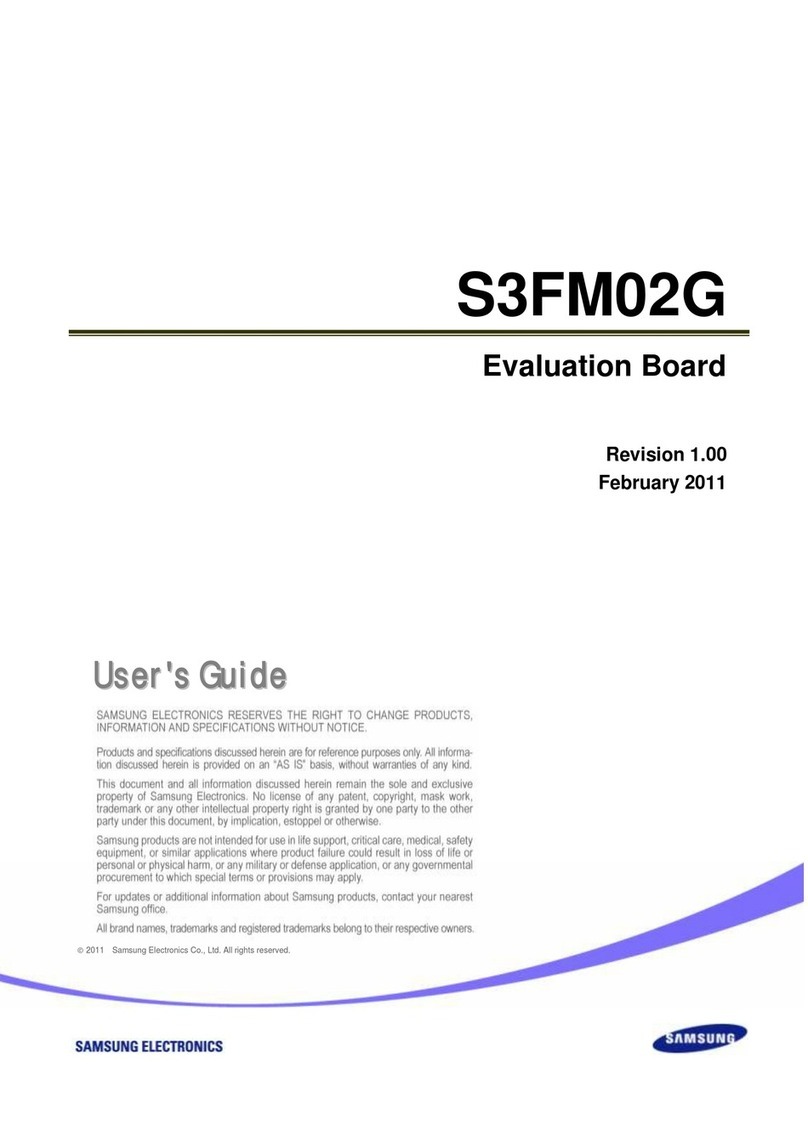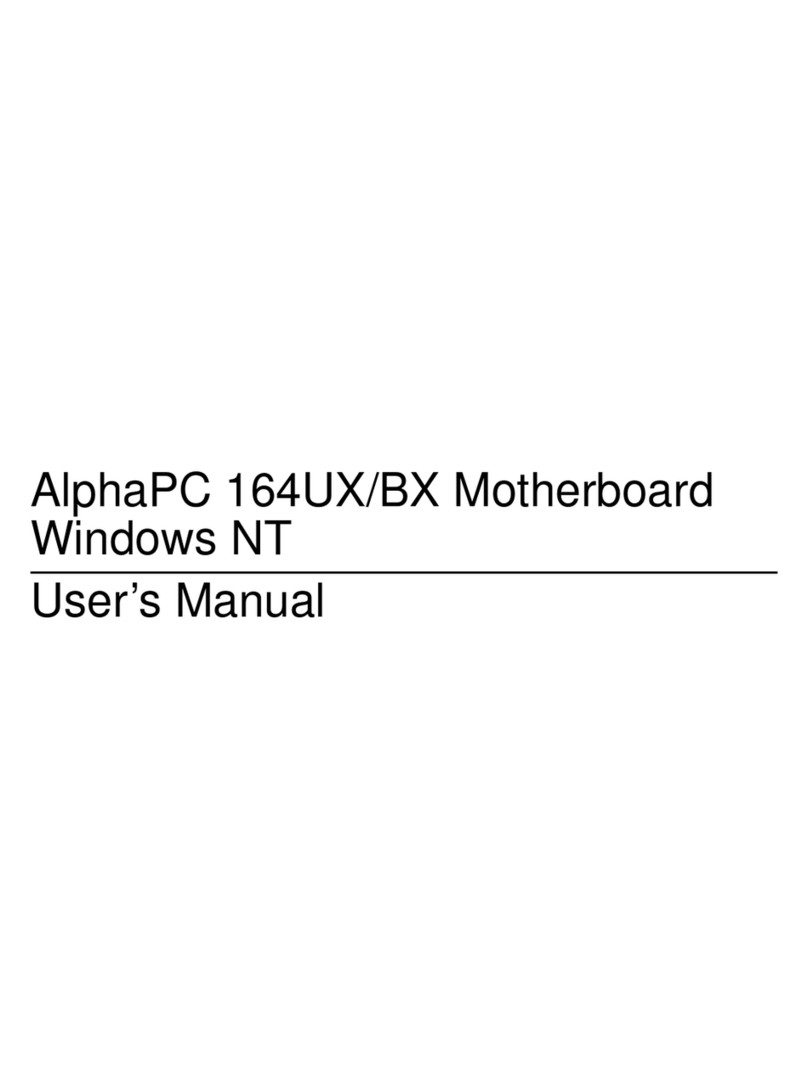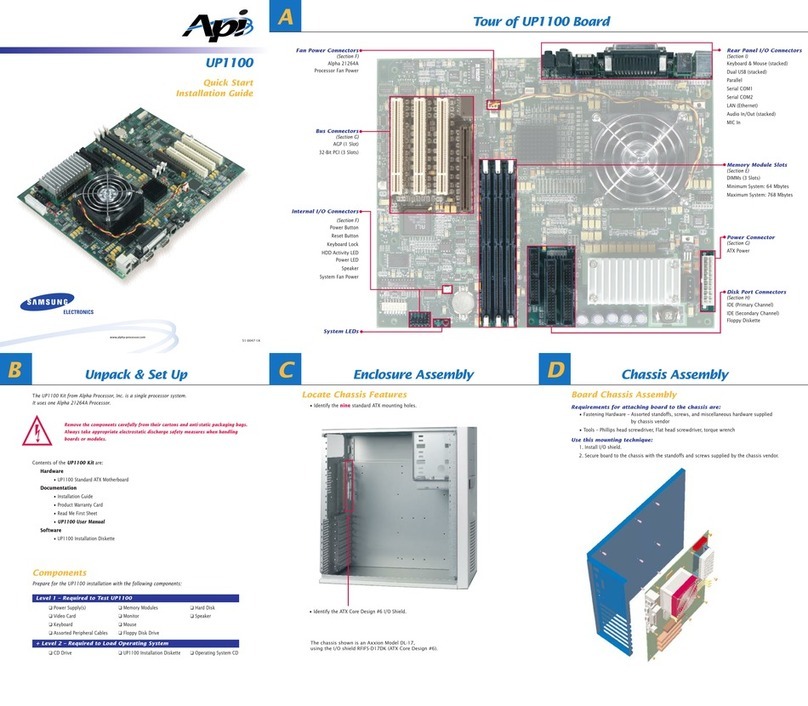viii
UXTables
1–1 AlphaPC 164UX SDRAM Memory Configurations . . . . . . . . . . . . . . . . . . . . . . . . . . . . 1–3
2–1 AlphaPC 164UX Jumper/Connector List . . . . . . . . . . . . . . . . . . . . . . . . . . . . . . . . . . . 2–3
2–2 PCI Bus Connector Pinouts . . . . . . . . . . . . . . . . . . . . . . . . . . . . . . . . . . . . . . . . . . . . . 2–5
2–3 ISA Expansion Bus Connector Pinouts (J10) . . . . . . . . . . . . . . . . . . . . . . . . . . . . . . . . 2–8
2–4 SDRAM DIMM Connector Pinouts (U3 through U8). . . . . . . . . . . . . . . . . . . . . . . . . . . 2–9
2–5 EIDE Drive Bus Connector Pinouts (J24). . . . . . . . . . . . . . . . . . . . . . . . . . . . . . . . . . . 2–10
2–6 Diskette (Floppy) Drive Bus Connector Pinouts (J33) . . . . . . . . . . . . . . . . . . . . . . . . . 2–11
2–7 Parallel Bus Connector Pinouts (J13). . . . . . . . . . . . . . . . . . . . . . . . . . . . . . . . . . . . . . 2–11
2–8 COM1/COM2 Serial Line Connector Pinouts (J12) . . . . . . . . . . . . . . . . . . . . . . . . . . . 2–12
2–9 Keyboard/Mouse Connector Pinouts (J25). . . . . . . . . . . . . . . . . . . . . . . . . . . . . . . . . . 2–12
2–10 Input Power Connector Pinouts (J18). . . . . . . . . . . . . . . . . . . . . . . . . . . . . . . . . . . . . . 2–13
2–11 Narrow SCSI Bus Connector (J16). . . . . . . . . . . . . . . . . . . . . . . . . . . . . . . . . . . . . . . . 2–13
2–12 Fast and Wide SCSI Bus Connector Pinouts(J15)) . . . . . . . . . . . . . . . . . . . . . . . . . . . 2–14
2–13 10/100 Mbit Ethernet Connector Pinouts (J34). . . . . . . . . . . . . . . . . . . . . . . . . . . . . . . 2–14
2–14 Speaker Connector Pinouts (J23). . . . . . . . . . . . . . . . . . . . . . . . . . . . . . . . . . . . . . . . . 2–15
2–15 Microprocessor Fan Power Connector Pinouts (J35). . . . . . . . . . . . . . . . . . . . . . . . . . 2–15
2–16 Power LED Connector Pinouts (J31) . . . . . . . . . . . . . . . . . . . . . . . . . . . . . . . . . . . . . . 2–15
2–17 IDE Drive LED Connector Pinouts (J29). . . . . . . . . . . . . . . . . . . . . . . . . . . . . . . . . . . . 2–16
2–18 Reset Switch Connector Pinouts (J37). . . . . . . . . . . . . . . . . . . . . . . . . . . . . . . . . . . . . 2–16
2–19 Soft Power Switch Connector Pinouts (J36). . . . . . . . . . . . . . . . . . . . . . . . . . . . . . . . . 2–16
2–20 SCSI LED Connector Pinouts (J17) . . . . . . . . . . . . . . . . . . . . . . . . . . . . . . . . . . . . . . . 2–16
3–1 ISA I/O Address Map . . . . . . . . . . . . . . . . . . . . . . . . . . . . . . . . . . . . . . . . . . . . . . . . . . 3–10
3–2 AlphaPC 164UX System Interrupts . . . . . . . . . . . . . . . . . . . . . . . . . . . . . . . . . . . . . . . 3–13
3–3 ISA Interrupts . . . . . . . . . . . . . . . . . . . . . . . . . . . . . . . . . . . . . . . . . . . . . . . . . . . . . . . . 3–14
5–1 Power Supply DC Current Requirements. . . . . . . . . . . . . . . . . . . . . . . . . . . . . . . . . . . 5–1
5–2 AlphaPC 164UX Motherboard Environmental Requirements. . . . . . . . . . . . . . . . . . . . 5–2
A–1 Physical Address Map (Byte/Word Mode Disabled). . . . . . . . . . . . . . . . . . . . . . . . . . . A–1
A–2 Physical Address Map (Byte/Word Mode Enabled) . . . . . . . . . . . . . . . . . . . . . . . . . . . A–2
A–3 21164 Byte/Word Addressing. . . . . . . . . . . . . . . . . . . . . . . . . . . . . . . . . . . . . . . . . . . . A–14
A–4 21164 Byte/Word Translation Values . . . . . . . . . . . . . . . . . . . . . . . . . . . . . . . . . . . . . . A–14
A–5 Int4_valid and 21164 Address Relationship . . . . . . . . . . . . . . . . . . . . . . . . . . . . . . . . . A–19
A–6 PCI Memory Sparse-Space Read/Write Encodings . . . . . . . . . . . . . . . . . . . . . . . . . . . A–20
A–7 PCI Address Mapping. . . . . . . . . . . . . . . . . . . . . . . . . . . . . . . . . . . . . . . . . . . . . . . . . . A–21
A–8 PCI Sparse I/O Space Read/Write Encodings . . . . . . . . . . . . . . . . . . . . . . . . . . . . . . . A–24
A–9 CPU Address to IDSEL Conversion . . . . . . . . . . . . . . . . . . . . . . . . . . . . . . . . . . . . . . . A–28
A–10 PCI Configuration Space Read/Write Encodings . . . . . . . . . . . . . . . . . . . . . . . . . . . . . A–29
A–11 Hardware and Miscellaneous Address Map . . . . . . . . . . . . . . . . . . . . . . . . . . . . . . . . . A–31
A–12 PCI Target Window Mask Register Fields . . . . . . . . . . . . . . . . . . . . . . . . . . . . . . . . . . A–33
A–13 Direct-Mapped PCI Target Address Translation. . . . . . . . . . . . . . . . . . . . . . . . . . . . . . A–37
A–14 Scatter-Gather Mapped PCI Target Address Translation. . . . . . . . . . . . . . . . . . . . . . . A–39
A–15 PCI Window Power-Up Configuration. . . . . . . . . . . . . . . . . . . . . . . . . . . . . . . . . . . . . . A–45
B–1 Samsung DIMM Part Number List . . . . . . . . . . . . . . . . . . . . . . . . . . . . . . . . . . . . . . . . B–1
B–2 VisionTek DIMM Part Number List . . . . . . . . . . . . . . . . . . . . . . . . . . . . . . . . . . . . . . . . B–2
B–3 Viking Components DIMM Part Number List . . . . . . . . . . . . . . . . . . . . . . . . . . . . . . . . B–2
B–4 QesTec DIMM Part Number List . . . . . . . . . . . . . . . . . . . . . . . . . . . . . . . . . . . . . . . . . B–2
B–5 Dense-Pac Microsystems DIMM Part Number List. . . . . . . . . . . . . . . . . . . . . . . . . . . . B–3



































